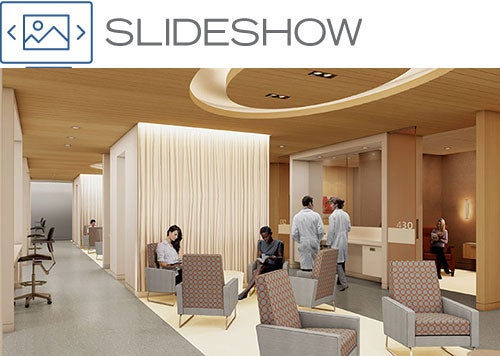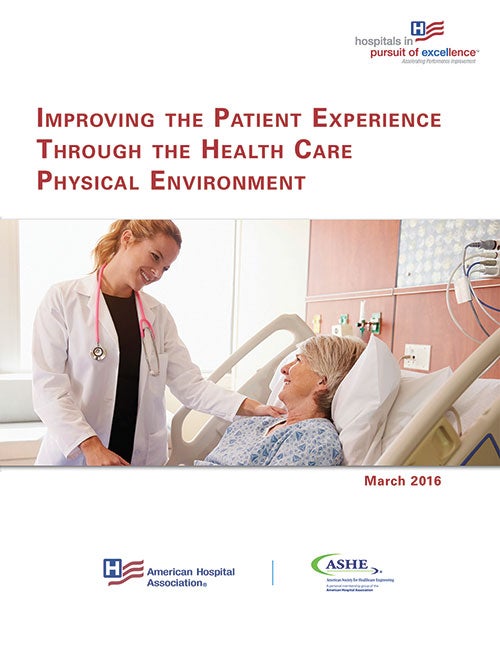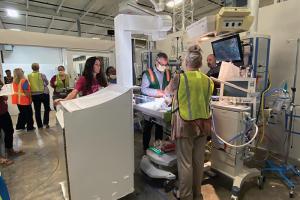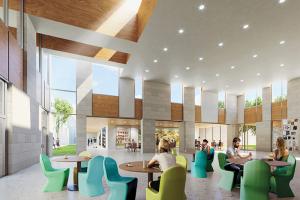Building patient satisfaction

As noted in a recent report by the American Hospital Association (AHA) and its American Society for Healthcare Engineering (ASHE), "Improving the Patient Experience Through the Health Care Physical Environment," patient experience is based on three important and related factors: people, process and place. Caring staff, patient-centered operations and well-designed facilities work together to support an excellent patient experience, a significant metric for attracting and retaining patients, maximizing reimbursement and achieving better outcomes. By providing environments in which people feel safe, comfortable and confident in the care they receive, hospitals and health systems can ensure a positive patient experience.
'Right thing to do'
The federal HCAHPS survey is an important measurement of patient experience. HCAHPS results help determine value-based incentive payments from the Centers for Medicare & Medicaid Services (CMS), as well as payments from many private insurers. To create additional incentives for high performance and provide patients with transparency regarding quality of care, HCAHPS survey data are publicly reported.
According to Susan W. Romano, MHA, patient experience consultant in the division of performance excellence for South Shore Hospital, South Weymouth, Mass., a subsidiary of South Shore Health System, it’s important for hospitals to score well on the HCAHPS survey for several reasons. “No. 1, it’s the right thing to do,” she says. HCAHPS questions cover areas like caregiver responsiveness and hospital cleanliness. “These are things every patient deserves,” says Romano.
“No. 2,” she adds, “consumerism is growing in health care. You’re not just going to go where your doctor sends you, you’re going where you choose to go.” Especially when it comes to elective procedures, “public reporting helps you to decide where and when you want to receive that clinical care,” Romano notes.
The third reason is the relationship between HCAHPS scores and reimbursement. “How we’re doing now in calendar year 2016 will determine what CMS, as well as many of our private payers, will pay us in fiscal year 2018. So, there is a financial piece to it. And at the end of the day — no margin, no mission,” she says.
You may also like |
| Facility manager’s role in patient satisfaction |
| Design’s impact on patient satisfaction |
| Study tests room design and patient satisfaction |
| ES customer service and patient satisfaction |
|
|
Rick Evans, senior vice president and chief experience officer, NewYork-Presbyterian, New York City, says higher patient experience scores have been correlated with better outcomes and higher margins for hospitals. He points to work by groups like the Beryl Institute, a patient experience think tank based in Bedford, Texas, that links good patient experiences with improved clinical outcomes. The NewYork-Presbyterian health system is a member of Planetree, a patient advocacy and research organization based in Derby, Conn., and is implementing the Planetree model of patient-centered care at five of the system’s hospitals.
Evans emphasizes that patient satisfaction is about more than simply making patients happy; it’s about delivering great care. “And I would argue that facilities play a key role,” he says. “What facilities can do is provide environments where patients feel safe. That has everything to do with design, color, functionality — where the handoffs and transitions are minimized, where communication is optimized. That’s the kind of thinking I see going into our facilities.”
Corresponding improvements
As shown in the AHA/ASHE report, several health care organizations have found that facility improvement projects have corresponded with improved patient experience ratings.
For example, to address scores related to the HCAHPS question about whether the hospital is quiet at night, Cleveland Clinic began by measuring the decibel levels on several patient units. While the levels weren’t substantially different from those at similar hospitals, “there was more noise than there should be, so that’s what we wanted to work on,” explains Joe Strauss, AIA, ACHA, director of planning and design.
The organization’s approach to the issue involved facilities, operations, technology and equipment, Strauss says. This included opportunities to mitigate noise by installing sound-absorbing ceiling tile and quieter door latches, holding rounds in rooms instead of corridors, turning off TVs that aren’t in use, setting pagers to vibrate mode, lowering the unit telephone ring volume, and replacing casters and wheels on rolled equipment with quieter models.
Following the implementation of several initiatives, HCAHPS scores for “always quiet at night” have risen six percentage points in two of the four participating units. Kelly Hancock, DNP, R.N., NE-BC, executive chief nursing officer at the Cleveland Clinic, says, “Clinicians might check off all of the important clinical boxes when caring for a patient, but it’s often the small — perhaps, nearly imperceptible — nonclinical elements of a hospital stay that most affect whether a patient has a good experience.”
Strauss says Cleveland Clinic is working with an acoustic engineer in the design of new facility projects to determine the optimal layout and best materials for noise control on patient units.
Enloe Medical Center, Chico, Calif., is another member of the Planetree organization for patient-centered care. Planetree president Susan Frampton says, “If we’re all in this to improve treatment and outcomes, then we have to use every tool that’s available, and that includes aspects of the built environment.” The medical center incorporated noise control features into the design of the new Magnolia Tower, a patient tower created as part of a design-build project with HBE Corp., St. Louis.
On the new units, nurse stations have associated conference and meeting room spaces to decrease the amount of conversation in the corridors. Private work spaces were created for physicians and case managers. The nurse call system was upgraded to provide direct notification via a system of lights at the patient door, instead of loud alarms. Overhead paging was eliminated. Every patient room is private, with the bed offset by a small entry area so the patient is exposed to less direct noise from outside the room. Acoustic ceiling tiles and sheet vinyl flooring help to absorb sound on the units.
“You don’t realize how pervasive noise is, and the effect that it has on you, until it’s decreased,” says Marcia Nelson, M.D., MMM, CPE, FAAFP, FAAPL, vice president of medical affairs at Enloe Medical Center. After Magnolia Tower opened, Nelson measured decibel readings throughout Enloe’s 5th Ave. Tower, which was built in the 1980s, and the new tower. “Just stepping over the threshold, it was about a three-decibel decrease going from the old tower to the new,” she says. Acoustic materials used in Magnolia Tower are being added to the older building.
“When we started our HCAHPS journey, our ‘quiet at night’ scores were down in the fifth percentile. Thirty-five percent of patients said their hospital room was always quiet at night,” says Nelson. The medical center’s publicly reported “quiet at night” score is currently 59 percent; according to Nelson; in recent quarters this score has been as high as 63 percent. In addition, 80 percent of patients surveyed recently said they would “definitely recommend” the hospital. “It’s a great sense of pride for us that our patients are feeling the benefits of all these efforts,” Nelson says.
Community collaboration
Romano’s facility, South Shore Hospital, was in the midst of a hospitalwide patient experience improvement process when the organization had the opportunity to create a new orthopedics unit as part of a vertical expansion of the hospital’s Emerson Building, designed by the Boston office of architecture firm CannonDesign.
The project was “a complete collaboration” among the hospital, patients and families, Romano says. In contrast with the older unit, the new space is filled with natural light and features all private rooms. Large whiteboards in the patient rooms facilitate communication between caregivers and patients. A family zone in each room with a convertible sleeper couch encourages family involvement in patient care. Wide, spacious hallways that end in floor-to-ceiling glass provide an environment that encourages patients to be mobile, as well as plenty of room for them to work with therapists. Sound-absorbing ceiling tiles and flooring help to minimize noise on the unit. Nurse stations positioned on either end of the unit place nurses closer to all their patients than did the older design in which a central nurse station was distant from some rooms.
“I can’t say enough about our ortho floor on HCAHPS across the board,” says Romano. Before the new unit opened, 52 percent of patients scored the hospital staff as “always responsive.” Now, 89.9 percent of patients surveyed have rated the staff as "always responsive." The percentage of patients who would “definitely recommend” the hospital has gone up from 64 to 88 percent.
At Lee Memorial Health System’s Cape Coral (Fla.) Hospital, “we pride ourselves on being the center for health, wellness and well-being in the community,” says Scott Kashman, chief administrative officer. The hospital has been working with the Samueli Institute, a health care research organization headquartered in Alexandria, Va., and health care design research firm Enviah, Grand Rapids, Mich., to create a physical environment that supports patients, families, hospital employees, volunteers, physicians and the broader community of Cape Coral. As part of this effort, the hospital developed a 1.1-mile path known as the “Pathway to Discovery” that winds around the 43-acre campus. The pathway includes exercise stations, garden areas that can be used for rehabilitative therapy, a teaching garden with planters donated by the American Heart Association (which also supplied a curriculum for educating school kids about healthful fruits and vegetables) and spaces for quiet relaxation. The community-funded project, built in conjunction with the City of Cape Coral, is open to the public. It is situated at the intersection of two streets, Kashman notes: Wellness Way and One Community Way.
Following completion of the Pathway to Discovery and other hospital projects, Cape Coral Hospital’s “top box” HCAHPS scores (the most positive survey responses) rose from 57 to 68 percent.
Effective environment
Parkview Regional Medical Center (PRMC), Fort Wayne, Ind., was built to enable the hospital to relocate tertiary services from a 60-year-old building that is now being renovated to continue hospital services and programs. Operational efficiency, patient and staff safety and stress-reducing design were among the primary goals of the PRMC project, according to architecture firm HKS Inc., Dallas. Specific design features intended to improve the patient experience include storage space for patient and family belongings, large windows that maximize natural daylight and provide exterior views from the patient bed, built-in window blinds for privacy and sound attenuation between patient spaces to lower noise. In addition, unit layouts were designed with reduced walking distances to allow caregivers to be more responsive to patient needs.
Kate Renner, AIA, EDAC, Lean-Six Sigma CE, associate, HKS, says, “If we can create a clean, quiet, effective environment, then we’re definitely doing a service to our clients. If your staff are able to respond quicker to a patient due to the design of the unit, then you’re improving another HCAHPS score. Direct return on investment is tied so specifically now to those scores.”
HKS’ nonprofit research organization, the Center for Advanced Design Research and Evaluation (CADRE), reports that since PRMC opened, the hospital’s overall HCAHPS rating has risen to 83 percent, up from 73 percent for the prior facility. Eighty-two percent of patients say they would recommend the hospital, up from 74 percent. And 69 percent of patients find the hospital quiet at night, up from 51 percent. Higher HCAHPS scores at the facility have corresponded with advancements in other performance improvement measures, including reduced numbers of patient falls and staff injuries, lower pressure ulcer/infection rates and increased volume and market share growth.
Setting the stage
Upali Nanda, associate AIA, EDAC, associate principal and director of research for HKS, says that while facility design alone cannot automatically raise HCAHPS scores, a systemic approach to facility projects that includes research and operational planning can contribute to a health care organization’s ability to provide excellent patient experiences. She notes that the patient's experience of care is ultimately based on human behavior, and quality design “can set the stage for that human behavior as best we can.”
Amy Eagle is a freelance journalist based in Homewood, Ill., who specializes in health care-related topics. She is a regular contributor to Health Facilities Management.







